Maple Trees
On this page: red maple, norway maple, sugar maple, silver maple, black maple
An excellent tree selector service [leave site] »
Identify your tree leaf [leave site] »
Maple tree culture and habits [leave site] »
Red Maple
Acer rubrum
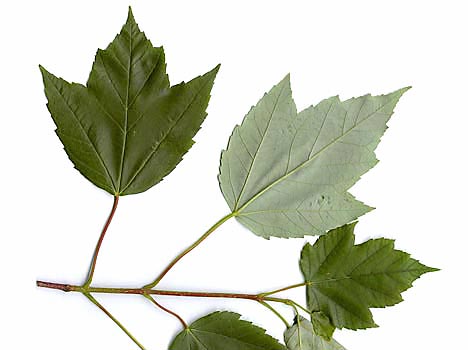 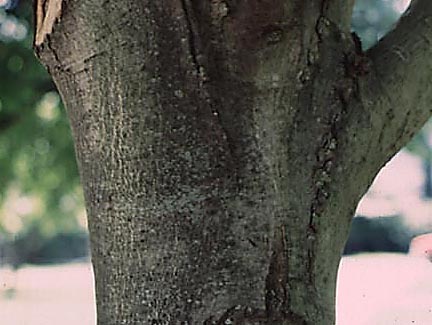 |
The red maple is usually a medium-sized tree with a moderate growth rate. The bark is smooth and light gray on young- and intermediate-aged stems, while mature bark is dark gray and rough. Crushed twigs do not emit a rank odor as does the silver maple. Twigs are reddish and have rounded, oblong, vegetative buds. Floral buds are globose and conspicuous, since they are borne in clusters. Lower branches tend to sweep upward.
The species makes an excellent suburban or rural landscape tree in acid soil regions of the state. Numerous cultivars are available and are marketed based on fall color and habit. This tree has an acid soil requirement and is intolerant of wounding. With red maples, manganese deficiencies are common in neutral to alkaline soils.
Leaves: The leaves of the Red Maple are very roughly toothed with 3-5 shallow lobes. Most of the Red Maple leaves are a light or a pale green to a whitish. During Autumn, leaves turn a bright red or an bright orange.
Twigs: Most Red Maple twigs appear to be slender and glossy. At first the twigs are green but later in the year they turn a red.
Fruit: The dioecious, red flowers are borne in dense clusters and appear in March or April before the leaves; the buds turn a deep red sometime before they open. Male trees can be planted if you do not want fruit. Fruits have wings spreading at narrow angles and ripen in May or June. The fruit consists of pairs of winged seeds, or keys, 1/2—1 inch in length on long, drooping stems. Fruit color ranges from red to green, becoming tan when mature.
Bark: On a young Red Maple the bark can be smooth and gray. On older trees, bark can appear to be darker and rougher with peeling flakes.
Other Important Facts: The Red Maple is found mostly in Pennsylvania. Most Red Maples grow to a length of about 50 feet high.
Norway Maple
More about Norway Maples [leave site]»
Acer plantanoids
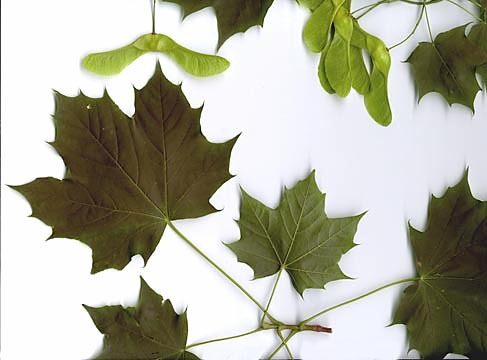 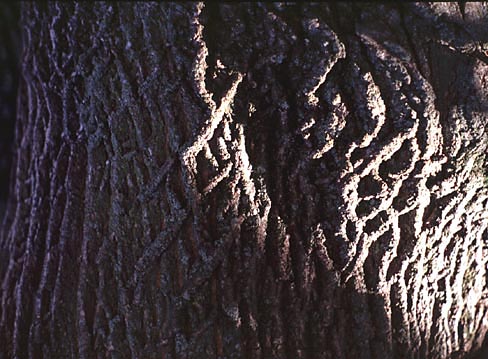 |
The Norway maple was one of the most popular street trees in the United States in the ‘60s and ‘70s. It originated in Europe where it is native from Norway to Switzerland. It is hardy, retains its leaves longer than the native maples, and endures the smoke, dust, and drought of the city, though it is susceptible to verticillium wilt and girdling roots.
Leaves: The Norway Maples leaves are very different than those of the Red Maple. These leaves are 5 lobed and 4-7 inches wide. A milky sap pours from the stalk if it is broken. One characteristic by which it can always be distinguished is the presence of milky sap in the leaf stalks. If pressed or twisted, the leaf stalks always yield a few drops of milky sap. Foliage color is bright green above and shiny beneath, except for the horticultural color variants that include wine, golden, and variegated forms. Fall foliage color is yellow for the green-foliaged forms.
Twigs:The Norway Maples twigs are a reddish-brown. Buds grow on the ends of the twigs. Buds are large (1/4 inch) and red or greenish-red with two to three pairs of bud scales; they are a sure means of identification in the winter. Buds are rounded rather than acute-tipped.
Fruit: In early spring, the yellow to chartruse flowers are arranged in 3-inch diameter clusters along the twigs. Flowers are borne in April or May. This maple has the most attractive flowers of all maples. Flowers are showy since they bloom before the foliage emerges. Fruit has horizontally spreading wings that mature in September or October.
Bark: On young trees the bark can appear to be light brown and smooth. As the trees get older the bark gets darker and rougher. The grayish-black bark is furrowed with shallow, narrow ridges forming a regular diamond pattern.
Other Important Facts: The Norway Maple is imported from Europe. This tree, like the Red Maple, can also reach a height of 50 feet. It is not similar to other maples because of the larger leaves, milky sap and horizontal winged fruit. Leaf shape very similar to sugar maple but more ornate. A milky sap appears when the leaf is broken off of stem at the petiole. This sap is not found in sugar maple leaves and distinguishes the two species.
Sugar Maple
Acer saccharum
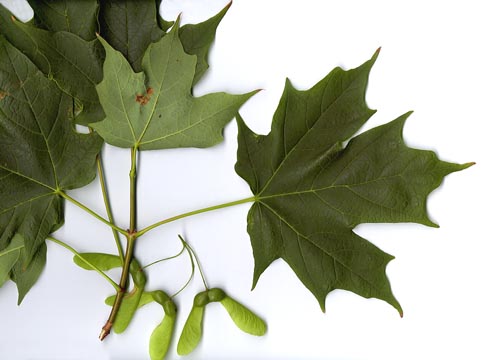 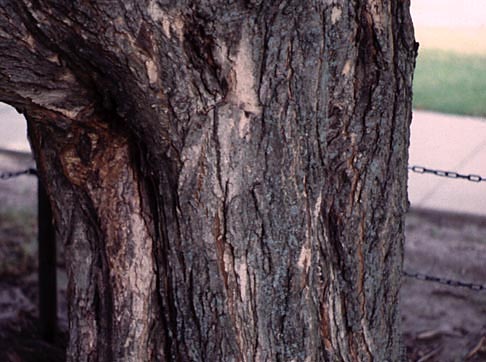 |
The tree attains a height of more than 100 feet and a diameter of 3 feet or more. It is generally a slow-growing tree. In the open, sugar maples have a symmetrical crown. It is extensively planted as a shade tree, although it is urban intolerant and should not be used in tree lawns.
Leaves: are simple, 5 lobed with very few large teeth, which are about 4" wide. The sinuses (division between the lobes) are rounded. The leaves are also a bright green towards the top,andpale green down to the bottom.These leaves turn bright yellow, orange or red in the fall.
Twigs: are a reddish-brown and go to a light brown. The twigs are smooth (glabrous) and reddish-brown in color. The winter buds are smaller than Norway maple and sharp-pointed with six to 10 pairs of scales.
Fruit: The flowers are yellowish-green, on long stalks, and appear with the leaves in April. Male and female flower clusters appear on the same tree. The fruit, which ripens in September, consists of a two-winged key. The two wings are nearly parallel, about 1 inch in length.
Bark: gray brown, smooth on young trunks, older trunks fissured with long, and irregular flakes. Bark is variable in this species. It is usually thin, smooth and gray on young trees, becoming thicker, darker and deeply furrowed into vertical, occasionally scaly ridges.
Differences:
The way to tell Red Maple and Sugar Maple apart is by the bark. The real difference is that the Red Maple has lighter and smoother bark then the Sugar Maple. Also the Red Maple has a bitter sap as compared to the Sugar Maple.
Silver Maple
Acer saccharinum (dasycarpum)
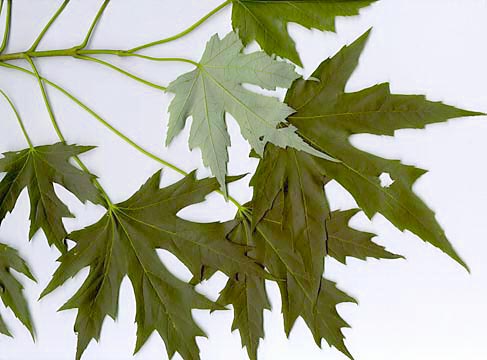 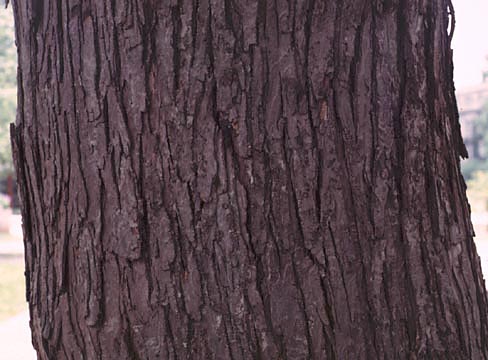 |
The silver or soft maple is most common on moist land and along streams. It attains heights of 100 feet or more and diameters over 3 feet. It usually has a short trunk which divides into a number of large, ascending limbs. These again subdivide, and small branches droop but turn upward at the tips. The silver maple grows rapidly and has widely been planted as a shade tree. The urban-tolerance of the silver maple makes it the longest-lived of the maples in urban settings.
The wood is soft, weak, even textured, rather brittle, easily worked, and decays readily when exposed to the elements.
Leaves Leaves are 3 to 6 inches long, opposite, simple, and palmately 5-lobed. Leaves are lobed more than half way to midrib. Margins are irregularly double-toothed. The leaf surfaces are glabrous, light green above and white to silvery below, giving it the common name "silver maple." Fall coloring is green to yellow-brown, and is not striking.
Twigs: The buds are rounded, red or reddish-brown, blunt-pointed, and generally like those of the red maple. Clusters of globose floral buds are also present on silver maple. Crushed twigs emit a rank odor.
Fruit: The flowers appear in February or March, before the leaves, in dense clusters and are of a greenish-yellow or reddish-yellow color. This may be the first native tree to flower, although the flowers are not showy. Fruits have divergent and curved wings that mature in May or June. It consists of a pair of winged seeds, or key, with wings 1—2 inches long on slender, flexible stems about an inch long. Fruit can be a litter problem, since they are borne in great numbers.
Bark The gray-brown bark is smooth on young trees, later developing irregular furrows with thin, gray, scaly plates.
Black Maple
Acer nigrum
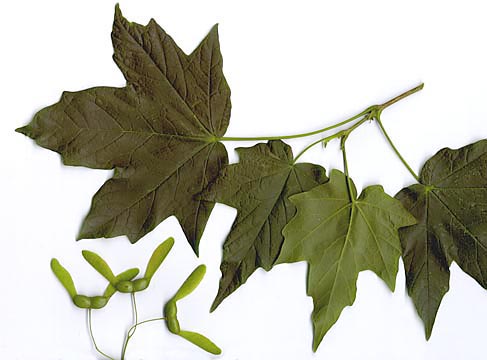 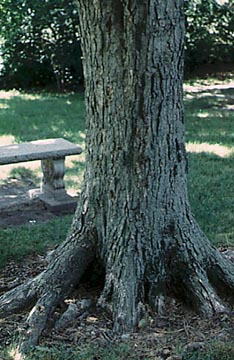 |
The black maple is a large, deciduous tree 60 to 80 ft in height with a dense, rounded crown and a straight trunk up to 4 ft in diameter. It is very similar to the sugar maple, with a few distinguishing characteristics: the leaves are usually palmately 3-lobed with hairy lower leaf surfaces, the leaf blades are thicker and characterisically drooping at the sides, twigs are orange-brown and the bark is almost black and more deeply furrowed.
Leaves: The leaves are simple, opposite, with a few coarse teeth along the margins, dark green on the upper surface and yellowish-green below. The fall color is yellow or brownish-yellow, sometimes red, but less so than the sugar maple. The 3 to 5-inch petioles often have leaf-like stipules at the base which obscure the lateral buds.
Fruit: Clusters of small, yellow flowers are produced in May at the base of newly-emerging leaves. The 0.5 to 1-inch-long winged fruits are produced in pairs. They mature and dry in late summer, sometimes separating when shed, leaving the hairy stalk on the tree.
Twigs: Winter buds are egg-shaped, with pointed tips and hairy, overlapping reddish-brown scales.
Bark: The bark of black maples is dark gray with deeply furrowed, irregular ridges. The bark is darker and more deeply furrowed than that of the sugar maple.
